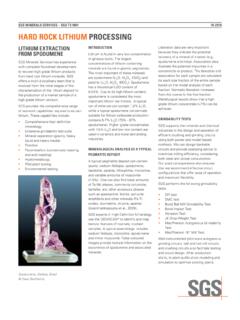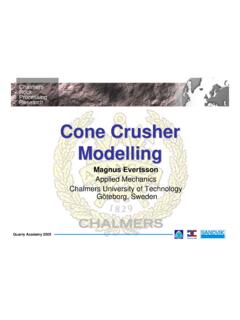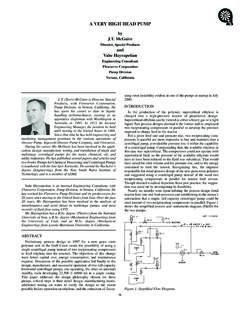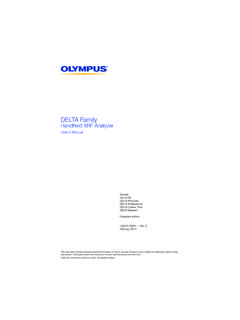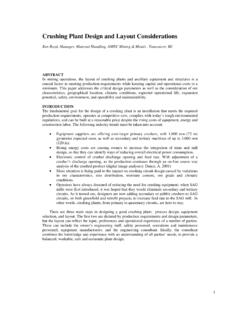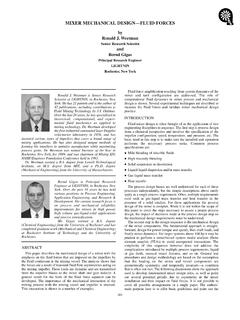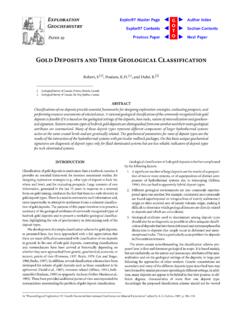Transcription of Models and Exploration Methods for Major Gold Deposit Types
1 Ore Deposits and Exploration Technology _____. Paper 48. Models and Exploration Methods for Major Gold Deposit Types Robert, F. [1] , Brommecker, R. [1], Bourne, B. T. [2] , Dobak, P. J. [3], McEwan, C..J. [4], Rowe, R. R. [2], Zhou, X. [1]. _____. 1. Barrick Gold Corporation, Toronto, ON, Canada 2. Barrick Gold of Australia Ltd., Perth, WA, Australia 3. Barrick Gold Exploration Inc., Elko, NV, 4. Compania Minera Barrick Chile Ltda., Providencia, Santiago, Chile ABSTRACT. Gold occurs as primary commodity in a wide range of gold Deposit Types and settings. In the last decade, significant progress has been made in the classification, definition and understanding of the main gold Deposit Types .
2 Three main clans of deposits are now broadly defined, each including a range of specific Deposit Types with common characteristics and tectonic settings. The orogenic clan has been introduced to include vein-type deposits formed during crustal shortening of their host greenstone, BIF or clastic sedimentary rock sequences. Deposits of the new reduced intrusion-related clan share an Au-Bi-Te-As metal signature and an association with moderately reduced equigranular post-orogenic granitic intrusions. Oxidized intrusion-related deposits, including porphyry, skarn, and high-sulfidation epithermal deposits, are associated with high-level, oxidized porphyry stocks in magmatic arcs. Other important Deposit Types include Carlin, low-sulfidation epithermal, Au-rich VMS and Witwatersrand deposits.
3 The key geology features of the ore-forming environments and the key geologic manifestations of the different Deposit Types form the footprints of ore systems that are targeted in Exploration programs. Important progress has been made in our ability to integrate, process, and visualize increasingly complex datasets in 2D GIS and 3D platforms. For gold Exploration , important geophysical advances include airborne gravity, routine 3D inversions of potential field data, and 3D modeling of electrical data. Improved satellite-, airborne- and field-based infrared spectroscopy has significantly improved alteration mapping around gold systems, extending the dimensions of the footprints and enhancing vectoring capabilities.
4 Conventional geochemistry remains very important to gold Exploration , while promising new techniques are being tested. Selection of the appropriate Exploration Methods must be dictated by the characteristics of the targeted model, its geologic setting, and the surficial environment. Both greenfield and brownfield Exploration contributed to the discovery of Major gold deposits (> moz Au) in the last decade but the discovery rates have declined significantly. Geologists are now better equipped than ever to face this difficult challenge, but geological understanding and quality field work were important discovery factors and must remain the key underpinnings of Exploration programs.
5 Cu-Au porphyries and Au-rich VMS deposits are not discussed INTRODUCTION because they are the object of separate papers in this volume, as well as the Witwatersrand-type gold deposits, which are more than adequately reviewed in recent literature (Frimmel et al., Significant progress has been made on the classification and 2005; Law and Phillips, 2005). understanding of gold deposits since the Exploration 1997. Exploration is mainly preoccupied with defining the footprints conference. Perhaps even more substantial progress has been made in the fields of Exploration geochemistry, geophysics, and of known gold deposits and with integrating various techniques with geology for their efficient identification and detection.
6 Data integration, providing better tools to assist the discovery of Accordingly, the first part of the paper reviews the main Types of new gold deposits. The objectives of this paper are to provide an gold deposits and the key elements of their footprints, defined update on gold Deposit Models , and what new approaches and techniques can now be used to find gold deposits. Gold occurs in here as the combined characteristics of the deposits themselves and of their local to regional settings. The second part deals with a wide range of Deposit Types and settings, but this paper is concerned with deposits in which gold forms the main economic the techniques and approaches that can now be used for the recognition and detection of these footprints.
7 Commodity or a co-product. Deposits in which gold occurs only as a by-product are not considered, including IOCG deposits. _____. In "Proceedings of Exploration 07: Fifth Decennial International Conference on Mineral Exploration " edited by B. Milkereit, 2007, p. 691-711. 692 Plenary Session: Ore Deposits and Exploration Technology _____. OVERVIEW OF GOLD SYSTEMS environments of formation. Minor Types of gold deposits are not discussed in this paper. As proposed by Robert et al. (1997) and Much has been published on gold deposits in the last decade, Poulsen et al. (2000), many of these gold Deposit Types can be leading to (1) significant improvement in the understanding of grouped into clans, families of deposits that either formed by some Models , (2) the definition of new Types or sub- Types of related processes or that are distinct products of large scale deposits, and (3) the introduction of new terms.
8 However, hydrothermal systems. These clans effectively correspond to the significant uncertainty remains regarding the specific distinction main classes of gold Models , such as the orogenic, reduced between some Types of deposits. Consequently, specific giant intrusion-related, and oxidized intrusion-r e l a t e d o n e s deposits are ascribed to different Deposit Types by different (Hagemann and Brown, 2000). Deposit Types such as Carlin, authors. In this paper, we have adopted the most accepted Au-rich VMS, and low-sulfidation are viewed by different nomenclature and Models used in important reviews published authors either as stand-alone Models or as members of the in the last decade ( Hagemann and Brown, 2000; Sillitoe and broader oxidized intrusion-related clan.)
9 They are treated here as Hedenquist, 2003). stand-alone Deposit Types , whereas high- and intermediate- As represented in Figure 1 and compiled in Table 1, thirteen sulfidation and alkalic epithermal deposits are considered as part globally significant Types of gold deposits are presently of the oxidized intrusion-related clan. Witwatersrand deposits recognized, each with its own well-defined characteristics and are still controversial and viewed either as modified paleoplacer or as orogenic deposits. Figure 1: Schematic cross section showing the key geologic elements of the main gold systems and their crustal depths of emplacement. Note the logarithmic depth scale. Modified from Poulsen et al.
10 (2000), and Robert (2004a). Robert, F., et al. Models and Exploration Methods for Major Gold Deposit Types 693. _____. possible connection with low-sulfidation alkalic epithermal Main Deposit Types and clans systems (Jensen and Barton, 2000). Other Types of globally important gold Deposit include low- and intermediate-sulfidation epithermal, Carlin, Au-rich VMS, The term orogenic has been originally introduced by Groves et al. (1998) in recognition of the fact that quartz-carbonate vein and Witwatersrand type deposits (Figure 1). Epithermal deposits are now subdivided into low-, intermediate- and high-sulfidation gold deposits in greenstone and slate belts, including those in BIF, have similar characteristics and have formed by similar categories on the basis of mineralization and alteration assemblages (Sillitoe and Hedenquist, 2003).
